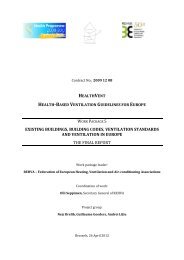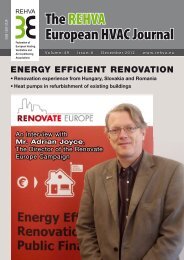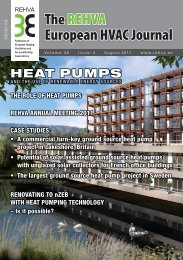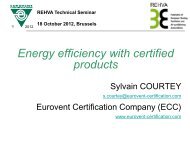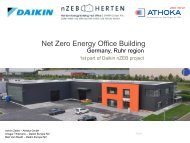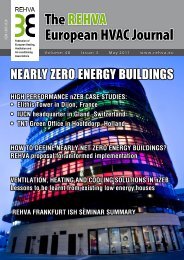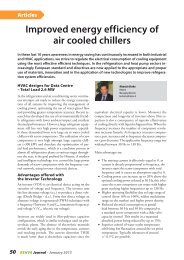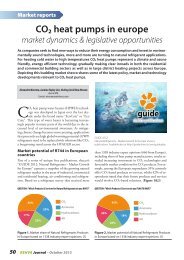Use of biofuels in the district heating system of Riga - rehva
Use of biofuels in the district heating system of Riga - rehva
Use of biofuels in the district heating system of Riga - rehva
Create successful ePaper yourself
Turn your PDF publications into a flip-book with our unique Google optimized e-Paper software.
Articles<br />
<strong>Use</strong> <strong>of</strong> bi<strong>of</strong>uels <strong>in</strong> <strong>the</strong><br />
<strong>district</strong> heat<strong>in</strong>g <strong>system</strong> <strong>of</strong> <strong>Riga</strong><br />
The <strong>in</strong>creas<strong>in</strong>g demand for energy, <strong>the</strong> shortage<br />
<strong>of</strong> <strong>the</strong> reserves <strong>of</strong> fuel, as well as <strong>the</strong> environment<br />
pollution and <strong>the</strong> global climate<br />
changes are <strong>the</strong> reasons for <strong>the</strong> grow<strong>in</strong>g<br />
<strong>in</strong>terest <strong>in</strong> renewable energy resources <strong>in</strong><br />
Latvia where <strong>the</strong> share <strong>of</strong> renewable energy<br />
resources account for one third <strong>in</strong> <strong>the</strong> total<br />
balance <strong>of</strong> primary energy resources. Wood<br />
and hydro energy are <strong>the</strong> two major types <strong>of</strong><br />
renewable energy resources. Latvia has set<br />
<strong>the</strong> goal to <strong>in</strong>crease <strong>the</strong> share <strong>of</strong> renewable<br />
energy resources up to 40% by 2020. The biggest<br />
possibilities for <strong>the</strong> use <strong>of</strong> local renewable<br />
energy resources refer to heat production<br />
– this applies to energy resources, like<br />
granulated wood or wood chips (here<strong>in</strong>after<br />
referred to as bi<strong>of</strong>uel) with <strong>the</strong> highest efficiency.<br />
This article demonstrates <strong>the</strong> use <strong>of</strong><br />
bi<strong>of</strong>uel and <strong>the</strong> possibilities <strong>of</strong> <strong>in</strong>creas<strong>in</strong>g its<br />
share, as well as measures for <strong>in</strong>creas<strong>in</strong>g <strong>the</strong><br />
efficiency <strong>of</strong> <strong>the</strong> bi<strong>of</strong>uel fired heat sources <strong>in</strong><br />
<strong>the</strong> <strong>district</strong> heat<strong>in</strong>g <strong>system</strong> <strong>of</strong> <strong>Riga</strong>.<br />
Normunds Talcis<br />
M.sc.<strong>in</strong>g. JSC<br />
„RĪGAS SILTUMS” Board Chairman, <strong>Riga</strong>, Latvia<br />
normunds.talcis@rs.lv<br />
to produce heat <strong>in</strong> cogeneration cycle and to use bi<strong>of</strong>uel,<br />
as well as o<strong>the</strong>r advanced technologies <strong>the</strong> application <strong>of</strong><br />
which is not efficient or feasible <strong>in</strong> local heat sources. At<br />
present JSC “RĪGAS SILTUMS” is <strong>the</strong> operator <strong>of</strong> <strong>the</strong><br />
<strong>district</strong> heat<strong>in</strong>g <strong>system</strong> <strong>in</strong> <strong>Riga</strong> and is <strong>in</strong> charge <strong>of</strong> provid<strong>in</strong>g<br />
heat energy supply to households, state authorities<br />
and bus<strong>in</strong>esses <strong>in</strong> <strong>Riga</strong>. JSC “RĪGAS SILTUMS”<br />
plays an important role <strong>in</strong> <strong>the</strong> heat supply <strong>of</strong> Latvia account<strong>in</strong>g<br />
for 53% <strong>of</strong> <strong>the</strong> total volume <strong>of</strong> <strong>the</strong> <strong>district</strong> heat<br />
supply provided by <strong>the</strong> <strong>district</strong> heat<strong>in</strong>g <strong>system</strong>s.<br />
The company purchases approximately 70% <strong>of</strong> <strong>the</strong> heat<br />
required for <strong>the</strong> needs <strong>of</strong> <strong>Riga</strong> city from CHP plants <strong>of</strong><br />
an <strong>in</strong>dependent producer and produces <strong>the</strong> rema<strong>in</strong><strong>in</strong>g<br />
approximately 30% by itself (Table 1).<br />
Table 1. Heat production capacities<br />
<strong>of</strong> <strong>the</strong> <strong>district</strong> heat<strong>in</strong>g <strong>system</strong>.<br />
Heat capacity, MW<br />
Owned by operator, <strong>in</strong>clud<strong>in</strong>g: 942<br />
DHP “Imanta” 405<br />
DHP “Ziepniekkalns” 104<br />
DHP “Zasulauks” 257<br />
DHP “Daugavgrīva” 32<br />
DHP “Vecmīlgrāvis” 63<br />
38 automated small local boiler houses 81<br />
Heat sources owned by o<strong>the</strong>rs, <strong>in</strong>clud<strong>in</strong>g: 1657<br />
TEC-1 493<br />
Egils Dzelzītis<br />
Dr.habil.sc.<strong>in</strong>g.<br />
<strong>Riga</strong> Technical University, <strong>Riga</strong>, Latvia<br />
egils@lafipa.lv<br />
District heat<strong>in</strong>g <strong>system</strong> <strong>in</strong> <strong>Riga</strong> was<br />
established <strong>in</strong> 1958<br />
District heat<strong>in</strong>g <strong>system</strong> consists <strong>of</strong> <strong>the</strong> supply network<br />
<strong>of</strong> heat energy and heat production sources for a city or<br />
a part <strong>of</strong> a city. The <strong>district</strong> heat<strong>in</strong>g <strong>system</strong> is a modern<br />
heat energy supply <strong>system</strong>, which provides a possibility<br />
TEC-2 1148<br />
Juglas jauda 16<br />
Total <strong>in</strong>stalled heat capacity 2599<br />
The implementation <strong>of</strong> <strong>the</strong> rehabilitation project <strong>of</strong> <strong>Riga</strong><br />
<strong>district</strong> heat<strong>in</strong>g <strong>system</strong> started <strong>in</strong> 1996 and was aimed at<br />
achiev<strong>in</strong>g considerable improvement <strong>of</strong> <strong>the</strong> efficiency <strong>of</strong><br />
<strong>Riga</strong> <strong>district</strong> heat<strong>in</strong>g <strong>system</strong>, ensur<strong>in</strong>g its competitiveness<br />
and reduc<strong>in</strong>g <strong>the</strong> impact <strong>of</strong> <strong>the</strong> <strong>district</strong> heat<strong>in</strong>g <strong>system</strong><br />
upon <strong>the</strong> environment. With<strong>in</strong> <strong>the</strong> framework <strong>of</strong><br />
<strong>the</strong> rehabilitation it was planned to elim<strong>in</strong>ate <strong>the</strong> centralised<br />
heat substations, to reconstruct <strong>in</strong>dividual heat<br />
28<br />
REHVA Journal – December 2012
substations and pipel<strong>in</strong>e networks, to close non-efficient<br />
medium and small capacity heat sources and to connect<br />
<strong>the</strong> relevant consumers to <strong>the</strong> <strong>district</strong> heat<strong>in</strong>g, as well as<br />
to reconstruct <strong>the</strong> major heat sources <strong>of</strong> JSC „RĪGAS<br />
SILTUMS”. In <strong>the</strong> course <strong>of</strong> implement<strong>in</strong>g <strong>the</strong> rehabilitation<br />
project <strong>the</strong> arrangement <strong>of</strong> <strong>the</strong> heat meter<strong>in</strong>g <strong>system</strong>,<br />
improvement <strong>of</strong> <strong>the</strong> service level and establishment<br />
<strong>of</strong> <strong>the</strong> possibilities <strong>of</strong> control <strong>of</strong> <strong>the</strong> heat consumption by<br />
heat consumers were def<strong>in</strong>ed as <strong>the</strong> priority areas.<br />
Individual heat meter<strong>in</strong>g <strong>in</strong>stalled<br />
from 1996<br />
3000 heat meters were <strong>in</strong>stalled <strong>in</strong> <strong>Riga</strong> until September<br />
1996 based upon <strong>the</strong> <strong>in</strong>itiative <strong>of</strong> <strong>the</strong> house owners. In <strong>the</strong><br />
course <strong>of</strong> implement<strong>in</strong>g <strong>the</strong> guidel<strong>in</strong>es <strong>of</strong> <strong>the</strong> rehabilitation<br />
project <strong>of</strong> <strong>the</strong> <strong>district</strong> heat<strong>in</strong>g <strong>system</strong>, <strong>the</strong> <strong>in</strong>stallation<br />
<strong>of</strong> heat meters started <strong>in</strong> 1996 both at consumer side and<br />
<strong>in</strong> heat sources. The costs <strong>of</strong> procurement and <strong>in</strong>stallation<br />
<strong>of</strong> heat meters were <strong>in</strong>cluded <strong>in</strong> <strong>the</strong> heat tariff. In October<br />
1997 <strong>the</strong> <strong>in</strong>stallation <strong>of</strong> 6000 heat meters was completed<br />
and it permitted to transfer to <strong>the</strong> <strong>system</strong> <strong>of</strong> settlements<br />
with heat consumers based upon <strong>the</strong> actual consumption<br />
<strong>of</strong> heat. The meter<strong>in</strong>g <strong>of</strong> actual heat consumption encouraged<br />
<strong>the</strong> arrangement <strong>of</strong> <strong>the</strong> <strong>in</strong>ternal heat supply <strong>system</strong>s<br />
<strong>of</strong> build<strong>in</strong>gs, thanks to <strong>the</strong> optimisation <strong>of</strong> <strong>the</strong> flow <strong>of</strong><br />
network water and hot water consumption. Residents, <strong>in</strong><br />
<strong>the</strong>ir turn, can accurately account for <strong>the</strong> consumed water<br />
based upon <strong>the</strong> read<strong>in</strong>gs <strong>of</strong> <strong>the</strong> meters <strong>in</strong>stalled <strong>in</strong> apartments<br />
and adjust <strong>the</strong>ir consumption to <strong>the</strong>ir economical<br />
abilities. Settlements for heat based upon meter read<strong>in</strong>gs<br />
<strong>in</strong>creased <strong>the</strong> consumers’ <strong>in</strong>terest to save <strong>the</strong> heat energy,<br />
supplied to <strong>the</strong> build<strong>in</strong>g, and to demand provision <strong>of</strong><br />
higher quality heat. The measures <strong>of</strong> sav<strong>in</strong>g and improv<strong>in</strong>g<br />
<strong>the</strong> heat quality yielded <strong>the</strong>ir results because <strong>the</strong> heat<br />
sales to households decreased.<br />
thous. MWh<br />
1200<br />
1000<br />
800<br />
600<br />
400<br />
200<br />
1126<br />
1007 969<br />
818<br />
Figure 1. Heat losses <strong>in</strong> DH networks.<br />
763 771 745<br />
637<br />
Individual heat substations<br />
Before 1997 approximately 46% <strong>of</strong> <strong>the</strong> heat consumers<br />
connected to <strong>Riga</strong> <strong>district</strong> heat<strong>in</strong>g <strong>system</strong> received heat<br />
via central heat substations (places where <strong>the</strong> heat carrier<br />
is produced for ensur<strong>in</strong>g space heat<strong>in</strong>g and domestic<br />
hot water supplies to a group <strong>of</strong> build<strong>in</strong>gs). When hot<br />
water was supplied and space heat<strong>in</strong>g was provided via<br />
<strong>the</strong> central heat substations it was not possible to guarantee<br />
<strong>the</strong> high quality <strong>of</strong> service to <strong>the</strong> customers. In autumn<br />
and spr<strong>in</strong>g periods <strong>the</strong> premises were overheated<br />
(<strong>the</strong> adjustment possibilities were limited). In <strong>the</strong> result<br />
heat was not used efficiently. For <strong>the</strong> purpose <strong>of</strong> provid<strong>in</strong>g<br />
<strong>the</strong> required amount and quality <strong>of</strong> heat to heat<br />
consumers, improv<strong>in</strong>g <strong>the</strong> security <strong>of</strong> <strong>the</strong> heat supply<br />
and achiev<strong>in</strong>g more efficient use <strong>of</strong> heat JSC “RĪGAS<br />
SILTUMS” was consistently implement<strong>in</strong>g <strong>the</strong> measures<br />
aimed at reduc<strong>in</strong>g <strong>the</strong> heat demand, <strong>in</strong>clud<strong>in</strong>g <strong>the</strong><br />
implementation <strong>of</strong> <strong>the</strong> program <strong>of</strong> elim<strong>in</strong>ation <strong>of</strong> central<br />
heat substations and sett<strong>in</strong>g up <strong>in</strong>dividual automated<br />
heat substations. With<strong>in</strong> this program 3008 modern<br />
<strong>in</strong>dividual heat substations were constructed <strong>in</strong> <strong>the</strong><br />
build<strong>in</strong>gs. All <strong>the</strong> 185 central heat substations and <strong>the</strong><br />
hot water networks associated with <strong>the</strong>m with <strong>the</strong> total<br />
length <strong>of</strong> 134.77 km were elim<strong>in</strong>ated by <strong>the</strong> end <strong>of</strong><br />
2001. At present more than 8000 <strong>in</strong>dividual heat substations<br />
have been modernised.<br />
Reduction <strong>of</strong> heat transmission losses<br />
For <strong>the</strong> purpose <strong>of</strong> ensur<strong>in</strong>g <strong>the</strong> operation <strong>of</strong> <strong>the</strong> <strong>district</strong><br />
heat<strong>in</strong>g <strong>system</strong> and its competitiveness on <strong>the</strong> heat<br />
market <strong>the</strong> good technical condition <strong>of</strong> <strong>the</strong> elements<br />
<strong>of</strong> <strong>the</strong> heat supply <strong>system</strong>s has to be ma<strong>in</strong>ta<strong>in</strong>ed. The<br />
ma<strong>in</strong> and distribution heat networks are major elements<br />
<strong>of</strong> <strong>the</strong> <strong>district</strong> heat<strong>in</strong>g <strong>system</strong>. By ma<strong>in</strong>ta<strong>in</strong><strong>in</strong>g<br />
<strong>the</strong> good technical condition <strong>of</strong> <strong>the</strong> ma<strong>in</strong> and distribution<br />
heat networks JSC<br />
“RĪGAS SILTUMS”<br />
provides high quality<br />
heat supply to customers<br />
and is reduc<strong>in</strong>g<br />
transmission heat losses<br />
and leakages <strong>of</strong> <strong>the</strong><br />
heat carrier. Generally,<br />
thanks to <strong>the</strong> implementation<br />
<strong>of</strong> <strong>the</strong> measures<br />
aimed at reduc<strong>in</strong>g<br />
489 489<br />
<strong>the</strong> transmission heat<br />
losses it was possible to<br />
reduce <strong>the</strong> transmission<br />
heat losses <strong>in</strong> <strong>Riga</strong> <strong>district</strong><br />
heat<strong>in</strong>g <strong>system</strong> approximately<br />
2.3 times<br />
(Figure 1).<br />
581<br />
540<br />
461 461 451<br />
1997 1998 1999 2000 2001 2002 2003 2004 2005 2006 2007 2008 2009 2010 2011<br />
Articles<br />
REHVA Journal – December 2012 29
Articles<br />
Quality <strong>of</strong><br />
bi<strong>of</strong>uels<br />
In order to reduce dependence<br />
on one type <strong>of</strong> fuel,<br />
to improve <strong>the</strong> security <strong>of</strong><br />
heat supply and to reduce<br />
carbon dioxide emissions,<br />
<strong>the</strong> susta<strong>in</strong>able justified diversification<br />
<strong>of</strong> fuel was def<strong>in</strong>ed<br />
as <strong>the</strong> priority aimed<br />
at rapid and considerable<br />
<strong>in</strong>crease <strong>of</strong> <strong>the</strong> share <strong>of</strong> bi<strong>of</strong>uel.<br />
The requirements<br />
were set to<br />
• composition (bark,<br />
stones, sand, metal<br />
items, ice, etc.<br />
• fraction size:<br />
20…50 mm –<br />
89…90%, 100 mm<br />
– not exceed<strong>in</strong>g 1%, 5 mm ‐ not exceed<strong>in</strong>g 10%<br />
• heat<strong>in</strong>g value – 2800 kWh/kg;<br />
• moisture – 30…55%.<br />
Three types <strong>of</strong> production <strong>of</strong> <strong>the</strong> bi<strong>of</strong>uel were<br />
recognised:<br />
1. Planned production <strong>of</strong> energy wood chips by<br />
cutt<strong>in</strong>g <strong>the</strong> forest trees and chipp<strong>in</strong>g <strong>the</strong> round<br />
timber at specially equipped places;<br />
2. At <strong>the</strong> fell<strong>in</strong>g areas where <strong>the</strong> waste <strong>of</strong> <strong>the</strong> forest<br />
cutt<strong>in</strong>g works is be<strong>in</strong>g utilised (branches, stems,<br />
bushes, etc.) – <strong>the</strong> timber is chipped at <strong>the</strong> site<br />
and transported to boiler houses;<br />
3. In <strong>the</strong> course <strong>of</strong> clean<strong>in</strong>g <strong>the</strong> protective areas,<br />
construct<strong>in</strong>g roads and carry<strong>in</strong>g out <strong>the</strong> ma<strong>in</strong>tenance<br />
<strong>of</strong> overhead power l<strong>in</strong>es – <strong>the</strong> chipp<strong>in</strong>g <strong>of</strong><br />
<strong>the</strong> wood is done at <strong>the</strong> site and <strong>the</strong>n it is transported<br />
to boiler houses;<br />
<strong>Use</strong> <strong>of</strong> bi<strong>of</strong>uels <strong>in</strong> <strong>the</strong> <strong>Riga</strong> DH <strong>system</strong><br />
Tak<strong>in</strong>g <strong>in</strong>to account <strong>the</strong> particular circumstances<br />
when <strong>the</strong> operator <strong>of</strong> <strong>the</strong> <strong>district</strong> heat<strong>in</strong>g JSC “RĪGAS<br />
SILTUMS” can operate only <strong>the</strong> heat production<br />
plants owned by itself, <strong>the</strong> first bi<strong>of</strong>uel fired unit <strong>in</strong><br />
<strong>the</strong> <strong>district</strong> heat<strong>in</strong>g <strong>system</strong> <strong>of</strong> <strong>Riga</strong> was <strong>in</strong>stalled <strong>in</strong><br />
1996 at <strong>the</strong> heat plant “Daugavgrīva”. The bi<strong>of</strong>uel prefurnace<br />
with <strong>the</strong> heat capacity 7.5 MW and with <strong>the</strong><br />
efficiency rate up to 75% was added to <strong>the</strong> exist<strong>in</strong>g<br />
steam boiler.<br />
Figure2. The bi<strong>of</strong>uel fired boiler house at <strong>the</strong> plant Vecmilgravis.<br />
On September 30, 2008 <strong>Riga</strong> was <strong>the</strong> first European<br />
capital, which has signed <strong>the</strong> Covenant <strong>of</strong> Mayors.<br />
The Covenant <strong>of</strong> Mayors is <strong>the</strong> ma<strong>in</strong> document <strong>of</strong><br />
form<strong>in</strong>g <strong>the</strong> European energy policy unit<strong>in</strong>g 3000<br />
cities <strong>in</strong> <strong>the</strong> European Union and o<strong>the</strong>r countries.<br />
The Covenant <strong>of</strong> Mayors is an ambitious <strong>in</strong>itiative<br />
by <strong>the</strong> European Commission express<strong>in</strong>g <strong>the</strong> unilateral<br />
undertak<strong>in</strong>g to reduce <strong>the</strong> CO 2 emissions caused<br />
by <strong>the</strong> EU by 20% until 2020, and achiev<strong>in</strong>g this by<br />
means <strong>of</strong> improv<strong>in</strong>g energy efficiency by 20% and<br />
<strong>in</strong>creas<strong>in</strong>g <strong>the</strong> share <strong>of</strong> renewable energy sources <strong>in</strong><br />
<strong>the</strong> total energy consumption by 20%.<br />
Tak<strong>in</strong>g <strong>in</strong>to account <strong>the</strong> above, as well as <strong>the</strong> rapid<br />
<strong>in</strong>crease <strong>of</strong> natural gas prices and <strong>the</strong> support available<br />
from <strong>the</strong> EU structural funds, JSC „RĪGAS<br />
SILTUMS” has actively engaged <strong>in</strong> <strong>the</strong> use <strong>of</strong> bi<strong>of</strong>uel<br />
<strong>in</strong> its production sites. The use <strong>of</strong> bi<strong>of</strong>uel contributes<br />
to <strong>the</strong> fuel diversification aimed at more <strong>in</strong>tense use<br />
<strong>of</strong> local renewable energy resources and reduces <strong>the</strong><br />
impact <strong>of</strong> <strong>the</strong> natural gas upon <strong>the</strong> heat price.<br />
Along with <strong>the</strong> development <strong>of</strong> <strong>the</strong> bi<strong>of</strong>uel <strong>in</strong>c<strong>in</strong>eration<br />
technologies and <strong>in</strong> <strong>the</strong> course <strong>of</strong> cont<strong>in</strong>u<strong>in</strong>g<br />
<strong>the</strong> <strong>in</strong>crease <strong>of</strong> <strong>the</strong> share <strong>of</strong> bi<strong>of</strong>uel <strong>in</strong> <strong>Riga</strong> <strong>district</strong><br />
heat<strong>in</strong>g <strong>system</strong> <strong>in</strong> 2010 a bi<strong>of</strong>uel fired boiler<br />
house with <strong>the</strong> capacity <strong>of</strong> 14 MW and <strong>the</strong> efficiency<br />
rate up to 85% was constructed <strong>in</strong> <strong>the</strong> heat plant<br />
„Vecmīlgrāvis” (Figure 2) and it is operated at <strong>the</strong><br />
base load.<br />
30<br />
REHVA Journal – December 2012
Articles<br />
In summer period only <strong>the</strong> operation <strong>of</strong> <strong>the</strong> bi<strong>of</strong>uel<br />
fired boilers is envisaged <strong>in</strong> <strong>the</strong> heat plants<br />
„Daugavgrīva” and „Vecmīlgrāvis”. For <strong>the</strong> purpose<br />
<strong>of</strong> ensur<strong>in</strong>g <strong>the</strong> compensation for <strong>the</strong> daily chang<strong>in</strong>g<br />
heat loads - heat accumulators were <strong>in</strong>stalled <strong>in</strong> <strong>the</strong><br />
heat plants and <strong>the</strong>y are cover<strong>in</strong>g <strong>the</strong> heat loads dur<strong>in</strong>g<br />
<strong>the</strong> peak hours and charge <strong>the</strong> load <strong>of</strong> <strong>the</strong> boilers<br />
dur<strong>in</strong>g night hours.<br />
The development measures implemented at <strong>the</strong> heat<br />
plant „Vecmīlgrāvis” permitted to improve <strong>the</strong> operational<br />
efficiency <strong>of</strong> this heat source and has <strong>in</strong>creased <strong>the</strong><br />
share <strong>of</strong> use <strong>of</strong> <strong>the</strong> bi<strong>of</strong>uel <strong>in</strong> <strong>the</strong> total production scope<br />
from 2.4% to 6.4%.<br />
Fur<strong>the</strong>r development<br />
<strong>of</strong> <strong>the</strong> bi<strong>of</strong>uel usage<br />
By <strong>in</strong>creas<strong>in</strong>g <strong>the</strong> share <strong>of</strong> use <strong>of</strong> <strong>the</strong> bi<strong>of</strong>uel, <strong>the</strong> impact<br />
<strong>of</strong> <strong>the</strong> <strong>in</strong>crease <strong>of</strong> natural gas prices upon <strong>the</strong> heat<br />
production costs will be reduced. Currently two modernisation<br />
projects have been <strong>in</strong>itiated provid<strong>in</strong>g for <strong>the</strong><br />
<strong>in</strong>stallation <strong>of</strong> highly efficient heat production units us<strong>in</strong>g<br />
bi<strong>of</strong>uel:<br />
• a cogeneration unit produc<strong>in</strong>g up to 22 MW<br />
heat and 4 MW electricity with <strong>the</strong> total<br />
efficiency rate up to 97% will be <strong>in</strong>stalled at <strong>the</strong><br />
heat plant “Ziepniekkalns”;<br />
• <strong>the</strong> <strong>in</strong>stallation <strong>of</strong> <strong>the</strong> water heat<strong>in</strong>g boiler with<br />
<strong>the</strong> capacity <strong>of</strong> 20 MW and <strong>the</strong> fluidised bed<br />
furnace allow<strong>in</strong>g to burn a wide range <strong>of</strong> bi<strong>of</strong>uel<br />
is planned <strong>in</strong> <strong>the</strong> modernisation project <strong>of</strong> <strong>the</strong><br />
heat plant “Zasulauks”.<br />
In both above mentioned projects <strong>the</strong> flue gas utilisation<br />
technologies (flue gas condensers) will be <strong>in</strong>stalled ensur<strong>in</strong>g<br />
<strong>the</strong> efficiency rate <strong>of</strong> <strong>the</strong> boiler operation close to<br />
100%. The maximum automation level and construction<br />
<strong>of</strong> <strong>the</strong> automated storage <strong>of</strong> bi<strong>of</strong>uel is planned to be<br />
placed at <strong>the</strong> boiler houses. The implementation <strong>of</strong> <strong>the</strong><br />
projects will permit to save <strong>the</strong> natural gas consumption<br />
<strong>of</strong> approximately 11.2 mill. n.m³/year, at <strong>the</strong> same time<br />
<strong>in</strong>creas<strong>in</strong>g <strong>the</strong> consumption <strong>of</strong> bi<strong>of</strong>uel by approximately<br />
112 thous. loose m³/year.<br />
Follow<strong>in</strong>g <strong>the</strong> implementation <strong>of</strong> <strong>the</strong> projects <strong>of</strong> bi<strong>of</strong>uel<br />
at <strong>the</strong> heat plants “Ziepniekkalns” and “Zasulauks”<br />
<strong>the</strong> share <strong>of</strong> bi<strong>of</strong>uel <strong>in</strong> <strong>the</strong> total production volume will<br />
reach 5.82% (Figure 3).<br />
By year 2014, thanks to <strong>the</strong> implementation <strong>of</strong> <strong>the</strong> modernisation<br />
projects provid<strong>in</strong>g for <strong>the</strong> use <strong>of</strong> bi<strong>of</strong>uel <strong>in</strong> <strong>the</strong><br />
heat plants “Ziepniekkalns” and “Zasulauks”, <strong>the</strong> total<br />
consumption <strong>of</strong> bi<strong>of</strong>uel <strong>in</strong> <strong>Riga</strong> <strong>district</strong> heat<strong>in</strong>g <strong>system</strong><br />
will <strong>in</strong>crease from approximately 0.03 mill. loose m³<br />
per year to approximately 0.4 mill. loose m³ per year or<br />
more than 13 times.<br />
Along with <strong>the</strong> planned <strong>in</strong>crease <strong>of</strong> <strong>the</strong> share <strong>of</strong> energy<br />
produced on <strong>the</strong> basis <strong>of</strong> <strong>the</strong> bi<strong>of</strong>uel <strong>in</strong> <strong>the</strong> total volume<br />
<strong>of</strong> heat production for <strong>Riga</strong> <strong>district</strong> heat<strong>in</strong>g <strong>system</strong>, also<br />
measures for improv<strong>in</strong>g <strong>the</strong> efficiency <strong>of</strong> bi<strong>of</strong>uel fired<br />
heat sources are consistently implemented. In <strong>the</strong> near<br />
future, <strong>in</strong> addition to fossil bi<strong>of</strong>uel fired water heat<strong>in</strong>g<br />
boilers at <strong>the</strong> heat plant „Vecmīlgrāvis”, it is planned to<br />
<strong>in</strong>stalled condensers <strong>of</strong> flue gases. The condensers <strong>of</strong> flue<br />
gases will be <strong>in</strong>stalled <strong>in</strong> <strong>the</strong> flue gas channel beh<strong>in</strong>d <strong>the</strong><br />
boiler and flue gas treatment devices, and by means <strong>of</strong><br />
%<br />
7<br />
6<br />
Plan<br />
5.82<br />
5<br />
4<br />
Current situation<br />
3.87<br />
3.90<br />
3<br />
1.95<br />
2<br />
1<br />
0<br />
1.92 1.92 1.92 1.92<br />
1.32<br />
0.75 0.72<br />
2008 2009 2010 2011 2012 2013 2014<br />
Figure 3. Increase <strong>of</strong> <strong>the</strong> share <strong>of</strong> bi<strong>of</strong>uel <strong>in</strong> heat sources (%).<br />
REHVA Journal – December 2012 31
Articles<br />
spray<strong>in</strong>g water <strong>in</strong> <strong>the</strong> flue gas<br />
flow it is possible to recover<br />
a considerable portion <strong>of</strong> <strong>the</strong><br />
heat <strong>of</strong> <strong>the</strong> flue gas produced<br />
<strong>in</strong> <strong>the</strong> process <strong>of</strong> combustion<br />
<strong>of</strong> <strong>the</strong> bi<strong>of</strong>uel. The <strong>in</strong>stallation<br />
<strong>of</strong> <strong>the</strong> flue gas condenser will<br />
result <strong>in</strong> <strong>the</strong> <strong>in</strong>crease <strong>of</strong> <strong>the</strong> efficiency<br />
<strong>of</strong> use <strong>of</strong> <strong>the</strong> bi<strong>of</strong>uel<br />
by 15% (Figure 4), as <strong>the</strong><br />
temperature <strong>of</strong> emitted flue<br />
gases is decreased.<br />
100<br />
73 73 73<br />
Review<strong>in</strong>g fur<strong>the</strong>r possibilities<br />
<strong>of</strong> <strong>the</strong> use <strong>of</strong> wood chips<br />
60<br />
we have studied <strong>the</strong> implementation<br />
<strong>of</strong> <strong>the</strong> gasification<br />
<strong>of</strong> wood chips <strong>in</strong> heat production<br />
and power generation.<br />
Tak<strong>in</strong>g <strong>in</strong>to account that lowcapacity<br />
units are used now<br />
<strong>in</strong> practice we are plann<strong>in</strong>g to 350 000<br />
consider <strong>the</strong> possibilities <strong>of</strong> <strong>in</strong>stallation<br />
this type <strong>of</strong> equipment<br />
<strong>in</strong> <strong>the</strong> small scale heat<br />
300 000<br />
sources where <strong>the</strong> w<strong>in</strong>ter loads<br />
250 000<br />
range from 16 to 17 MW and<br />
200 000<br />
<strong>in</strong> summer <strong>the</strong> load decreases<br />
to 2 MW. Consider<strong>in</strong>g <strong>the</strong> 150 000<br />
high capital <strong>in</strong>vestment <strong>in</strong> <strong>the</strong><br />
wood chips gasification equipment<br />
it should be operated<br />
100 000<br />
50 000 15 291<br />
for <strong>the</strong> maximum number <strong>of</strong><br />
1 254<br />
hours dur<strong>in</strong>g year. If <strong>the</strong> process<br />
<strong>of</strong> gasification <strong>of</strong> wood<br />
0<br />
chips is compared to <strong>the</strong> classic<br />
process <strong>of</strong> <strong>in</strong>c<strong>in</strong>eration <strong>of</strong><br />
wood chips <strong>the</strong> gasification<br />
process is characterised by a<br />
better proportion <strong>in</strong> produc<strong>in</strong>g<br />
heat and electricity. Tak<strong>in</strong>g<br />
<strong>in</strong>to account that electricity is a much more pr<strong>of</strong>itable<br />
product that can be sold on <strong>the</strong> market, <strong>the</strong> technology<br />
with <strong>the</strong> maximum electricity generation dur<strong>in</strong>g a year<br />
is more pr<strong>of</strong>itable. It is planned to <strong>in</strong>stall <strong>the</strong> wood chips<br />
gasification unit with <strong>the</strong> heat capacity <strong>of</strong> 1.9 MW th and<br />
electrical capacity <strong>of</strong> 1.0 MW el.<br />
%<br />
95<br />
90<br />
85<br />
80<br />
75<br />
70<br />
65<br />
73<br />
2007 2008 2009 2010 2011 2012 2013 2014<br />
Figure 4. The dynamics <strong>of</strong> <strong>the</strong> improvement <strong>of</strong> <strong>the</strong> average efficiency <strong>of</strong> use <strong>of</strong> bi<strong>of</strong>uel.<br />
MWh th MWh el<br />
30 000<br />
307 853<br />
Bi<strong>of</strong>uel based heat production<br />
Bi<strong>of</strong>uel based electricity generation<br />
25 000<br />
24 267<br />
20 000<br />
181 611<br />
13 933<br />
15 000<br />
100 223<br />
10 000<br />
73 390<br />
2 030<br />
2 030<br />
5 000<br />
0<br />
2010 2011 2012 2013 2014<br />
Figure 5. Bi<strong>of</strong>uel based heat production and electricity generation.<br />
77<br />
Generation <strong>of</strong> electricity at bi<strong>of</strong>uel<br />
fired heat sources<br />
In order to improve <strong>the</strong> efficiency <strong>of</strong> a heat source, to<br />
provide auxiliary power supply and to sell <strong>the</strong> surplus<br />
electricity, which would contribute to <strong>the</strong> improvement<br />
<strong>of</strong> <strong>the</strong> overall efficiency <strong>of</strong> <strong>the</strong> <strong>district</strong> heat<strong>in</strong>g<br />
<strong>system</strong>, <strong>in</strong> 2004 <strong>the</strong> modernisation project <strong>of</strong> <strong>the</strong> heat<br />
plant „Daugavgrīva” was implemented with <strong>the</strong> <strong>in</strong>stallation<br />
<strong>of</strong> <strong>the</strong> steam turb<strong>in</strong>e with <strong>the</strong> electrical capacity<br />
<strong>of</strong> 0.5 MW el. and construction <strong>of</strong> <strong>the</strong> heat storage tank<br />
with <strong>the</strong> volume <strong>of</strong> 100 m³. In 2007 <strong>the</strong> capacity <strong>of</strong> <strong>the</strong><br />
turb<strong>in</strong>e was <strong>in</strong>creased up to 0.6 MW el. Due to <strong>the</strong> implementation<br />
<strong>of</strong> <strong>the</strong> modernisation project at <strong>the</strong> heat<br />
plant „Ziepniekkalns” – construction <strong>of</strong> <strong>the</strong> bi<strong>of</strong>uel fired<br />
cogeneration unit with <strong>the</strong> electrical capacity <strong>of</strong> 4 MW,<br />
<strong>the</strong> electricity generation based on bi<strong>of</strong>uel will <strong>in</strong>crease<br />
more than 19 times <strong>in</strong> 2014 compared to 2010 and will<br />
amount to 24 thous. MWh per year (see Figure 5).<br />
87<br />
91<br />
95<br />
32<br />
REHVA Journal – December 2012
Articles<br />
Conclusions<br />
In <strong>the</strong> current situation <strong>in</strong> <strong>the</strong> fuel market when <strong>the</strong><br />
prices <strong>of</strong> fossil fuels <strong>in</strong>crease rapidly <strong>the</strong> use <strong>of</strong> bi<strong>of</strong>uel<br />
for production <strong>of</strong> heat and generation <strong>of</strong> electricity is<br />
economically justified. However, I would also like to<br />
po<strong>in</strong>t out that each situation has to be analysed on case<br />
by case basis. The example described by me provides an<br />
<strong>in</strong>sight <strong>of</strong> <strong>the</strong> use <strong>of</strong> bi<strong>of</strong>uel <strong>in</strong> <strong>the</strong> <strong>district</strong> heat<strong>in</strong>g <strong>system</strong>.<br />
When a new bi<strong>of</strong>uel based technologies with high<br />
efficiency parameters are applied for <strong>the</strong> heat production,<br />
<strong>the</strong>se units can be used <strong>in</strong> <strong>the</strong> exist<strong>in</strong>g and newly<br />
constructed production sources.<br />
When bi<strong>of</strong>uel based energy production sources are built<br />
or reconstructed, <strong>the</strong> load <strong>of</strong> <strong>the</strong> units has to be carefully<br />
assessed. It is because <strong>the</strong> <strong>in</strong>vestments <strong>in</strong> bi<strong>of</strong>uel<br />
based units are much higher than <strong>the</strong> <strong>in</strong>vestments <strong>in</strong><br />
<strong>the</strong> units us<strong>in</strong>g natural gas. Therefore, <strong>in</strong> <strong>the</strong> course<br />
<strong>of</strong> plann<strong>in</strong>g it is necessary to ensure that <strong>the</strong> selected<br />
bi<strong>of</strong>uel based units use <strong>the</strong> heat produced <strong>in</strong> <strong>the</strong> process<br />
to <strong>the</strong> maximum extent and are loaded dur<strong>in</strong>g <strong>the</strong><br />
whole year.<br />
The <strong>district</strong> heat<strong>in</strong>g <strong>system</strong> provides a possibility for <strong>the</strong><br />
efficient use <strong>of</strong> bi<strong>of</strong>uel <strong>in</strong> heat sources because <strong>the</strong> heat<br />
sources are l<strong>in</strong>ked with<strong>in</strong> a common <strong>system</strong>. When several<br />
sources operate with<strong>in</strong> a jo<strong>in</strong>t <strong>system</strong> it is possible to<br />
ensure that <strong>the</strong> bi<strong>of</strong>uel based units are efficiently loaded.<br />
If <strong>the</strong> bi<strong>of</strong>uel based production sources are utilised efficiently<br />
with<strong>in</strong> <strong>the</strong> <strong>district</strong> heat<strong>in</strong>g <strong>system</strong> this provides<br />
an opportunity to produce heat <strong>the</strong> costs <strong>of</strong> which are<br />
competitive <strong>in</strong> <strong>the</strong> heat market.<br />
References<br />
[1] Zigurs A., Budjko Z., Cers A. etc. Biomass projects schemes<br />
<strong>in</strong> Latvia // 16th European Biomass Conference & Exhibition,<br />
Proceed<strong>in</strong>gs <strong>of</strong> <strong>the</strong> International Conference held <strong>in</strong><br />
Valencia, Spa<strong>in</strong> 2-6 June 2008. - Valencia: 16th European<br />
Biomass Conference & Exhibition, 2008. - 2443-2447.p.<br />
[2] Zigurs A., Budjko Z., Cers A. etc. Cost effective biomass<br />
conversion for energy <strong>in</strong> Latvia // 16th European Biomass<br />
Conference & Exhibition, Proceed<strong>in</strong>gs <strong>of</strong> <strong>the</strong> International<br />
Conference held <strong>in</strong> Valencia, Spa<strong>in</strong> 2-6 June 2008. - Valencia:<br />
16th European Biomass Conference & Exhibition, 2008. -<br />
1478-1482.p.<br />
[3] Zigurs A., Cers A., Jirgens M. etc. F<strong>in</strong>anc<strong>in</strong>g schemes for<br />
biomass <strong>in</strong> Latvia // World Susta<strong>in</strong>able Energy Days 2008. -<br />
Wels: World Susta<strong>in</strong>able Energy Days, 2008. - 1-9.p.<br />
Cool<strong>in</strong>g equipment with superior operational qualities and high performance levels!<br />
A Global Leader<br />
Hitema<br />
<strong>in</strong> <strong>system</strong> solutions for air condition<strong>in</strong>g, heat<strong>in</strong>g and<br />
refrigeration<br />
HVAC-Designs for Data Centers<br />
and Switch Rooms<br />
Total Load @ 4,5 MW<br />
Special and<br />
Customized<br />
Meet us at<br />
Hall 7 - Stand 316A<br />
Hitema, Global Presence<br />
Advanced technology, absolute quality and clos<strong>in</strong>g at <strong>the</strong> Customer strong po<strong>in</strong>ts that Hitema<br />
uses for its growth. Hitema is a Company that has shown competitive capacity and a big flexibility<br />
at Market requirements and it has been able to pay a lead<strong>in</strong>g role thanks to <strong>the</strong> ability to place<br />
good technological solution for <strong>in</strong>dustrial refrigeration, close control units and HVAC design for<br />
data center and switch rooms and compressed air treatment. Surely, determ<strong>in</strong>ated factors <strong>of</strong> our<br />
growth are <strong>the</strong> importance <strong>of</strong> <strong>the</strong> full satisfaction <strong>of</strong> <strong>the</strong> Customer and <strong>the</strong> various <strong>of</strong> <strong>the</strong> <strong>of</strong>fer,<br />
with new products marked by Innovation and Quality.<br />
Z.I. San Gabriele – 35024 Bovolenta (Padova) - Italy<br />
Tel.: +39 049 5386344 - Fax: +39 049 5386300<br />
E-mail: sales@hitema.it - Web page: www.hitema.it<br />
The ENGINEERED SOLUTION for FLEXIBILITY and PERFORMANCE<br />
REHVA Journal – December 2012 33




